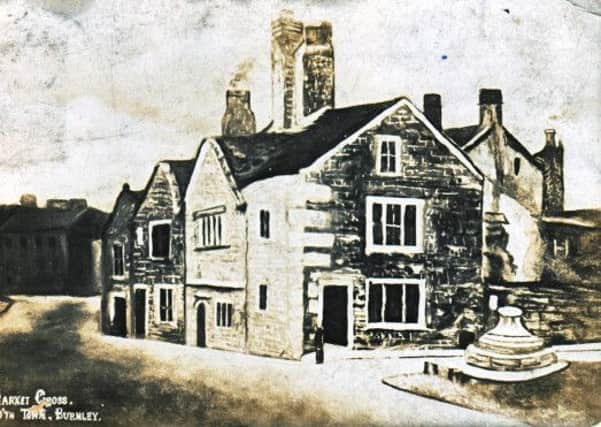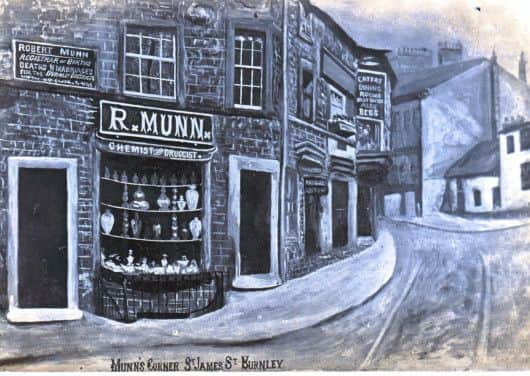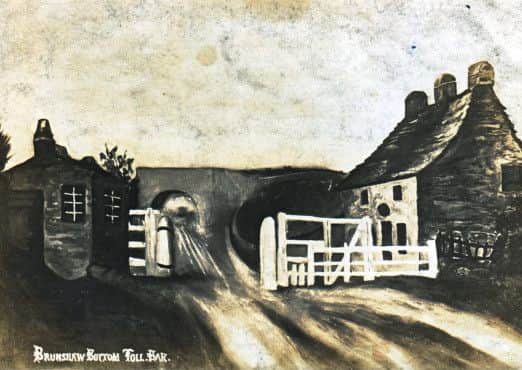Drawings feature forgotten views of Burnley


Today, we are looking at another four images all of which were originally drawings but were later published as postcards. Perhaps they were intended to be postcards all along? I will come to that later.
I ought to say, at the outset, I had indicated, on December 23rd, the article that day would be a “one off”, but, as I got into the article, I realised there was more to say about this kind of material than I had thought at first. This became more apparent when I was contacted by a reader who told me about an article, by Katherine Demaine, about the local artist Stocks Austerberry, published in “Northern Life”, June/July, 2011.
Advertisement
Hide AdAdvertisement
Hide AdI knew about Stocks Austerberry partly because some of his paintings had been published as postcards. The first one I had noted is a view of Burnley’s Market Cross and the Old Sparrow Hawk as it was, perhaps, in the 1880s. It is similar to the one “Old Market Cross, Top o’ th’ Town, Burnley” I use today, but Mr Austerberry’s original painting is much more the work of an artist.


Stocks Austerberry was born in Pontefract in 1847, probably the son of an Edward Stocks Austerberry, a painter, living in Beast Fair, Pontefract. We know little about Edward’s work but it was very common for towns to have resident artists at this time. Photography was in its infancy and local artists had served the community painting family portraits as well as images of successful businessmen, often sharing a canvas with a reproduction of the mill or foundry they had established.
In Blackburn several of this kind of painting were produced. The best-known is that of William Dickinson and his Phoenix Iron Works on Preston Old Road in the town. Incidentally, nothing now remains of the factory which is now demolished. The site is now occupied by St Wilfred’s CE High School at Bank Top. Another painting of this type is of Joseph Harrison, Blackburn’s leading loom maker in the middle years of the 19th Century. There is a third, the very well-known etching, by James Sharples, of the interior of an unnamed Blackburn foundry, thought to be the Eagle Foundry, in Starkie Street, which was at Salford in the centre of the town.
In Burnley we do not have images of this kind. The nearest thing we have is the painting, now at Towneley Hall, of the great cotton mill, owned by the Dugdale’s, at Lower House. This does not contain an image of a member of the family but is a splendid view of what was one of the most significant industrial buildings in Lancashire before it was demolished.
Advertisement
Hide AdAdvertisement
Hide AdOn the other hand, the paintings of Stocks Austerberry tell us much about Burnley and the surrounding area towards the end of the 19th Century. The “Northern Life” article lists nine images which are known to have survived. They include “Tattersall’s”, the Hurstwood home of Richard Tattersall whom I wrote about a few weeks ago; “The Market Cross and Old Sparrow Hawk”, which I have already mentioned; “Extwistle Hall”, “Barcroft Hall”, “Read Hall”, “Worsthorne Old Hall”, “Spencer’s Cottage”, “The Brunshaw Toll Bar” and “Danes House”.


It is not strictly right to say the images show Burnley and district as they were at the end of the 19th Century. Some do but the Austerberry painting of Read Hall is of the pre-1825 building and that of the Brunshaw Toll Bar shows Yorkshire Street, then known as Eastgate, years before the building of St Mary’s Church which dates from 1846. Similarly, the painting of the Market Cross and Old Sparrow Hawk probably shows that part of Burnley some time before 1880 when the old Market House was demolished to make way for the new tram lines.
That said, it is likely Mr Austerberry must have visited some of the places he painted. Tattersall’s in Hurstwood has changed little since the study Mr Austerberry made of it and the same can be said of Barcroft Hall and Spencer’s Cottage. With regard to the image of Extwistle Hall, a copy of which is in the Briercliffe Society Collection (though it has been printed back to front), it seems likely Mr Austerberry visited the site. Daneshouse was still standing in late Victorian times, so Mr Austerberry who died aged 52 in 1899, would have known it, and Worsthorne Old Hall was not demolished until late in Mr Austerberry’s life.
Of the images today the two with which Mr Austerberry would have been most familiar are those entitled, “Old Market Cross, Top o’ th’ Town, Burnley” and “Brunshaw Bottom Toll Bar”. For both we can ascertain they are fairly accurate artistic representations of the scenes depicted, though both show the localities years before the cards were published.
Advertisement
Hide AdAdvertisement
Hide AdWe know this from evidence provided by early maps of Church Street and what is now Yorkshire Street. The former, especially the street near St Peter’s, changed little until the later 19th Century when the Market House was demolished. This is the central building in the image. The base of the 17th Century market cross and stocks can be seen on the extreme right. Some think the iron post, close to the southern end of the Market House, could be the ancient whipping post but, equally, it might be a later bollard. Of the four images today, this is the only one to have been posted as a card and this took place in February, 1906.


The “Brunshaw Bottom Toll Bar” image is fairly accurate but I am concerned about the building on the left. It does not look like one would expect it to from the evidence supplied by a study of the maps of the early 19th Century. The cottage on the right, which stood where Burnley Cricket Field now is, is similar to what I expected it to be, and this is confirmed by photographic evidence, but perspective in the image is all wrong as is the length given to Yorkshire Street.
You will have seen the image of “Old Duke Bar” in my column before. Generally, again relying in early maps, the picture is fairly accurate though there are failings with regard to perspective. This can be seen in the relative sizes of the cottages, left, and the Toll House itself, centre. Notice, the artist has used the name “Hebrew Road Bar”, the old name for the building.
We know the first toll bar at this site dates from about 1780 when there was no pub at this location. The first reference to a “Duke of York” is made in 1824 and the name Duke Bar is a combination of the name of the hotel and the site of the toll bar. The present Duke of York, which is no longer a pub, was constructed in 1881, 20 years before the postcard was issued, so the artist, whoever he was, must have had images of the site before him when he was at work.
Advertisement
Hide AdAdvertisement
Hide AdThe last of the images is the most useful. It shows “Munn’s Corner, St James’s Street, Burnley”, as it was about 1880/1 when Burnley’s steam tramway was constructed. Bob Munn’s shop was situated where St James Street was joined by Water Street. The latter led down a steep hill to the district known as Wapping, once a fairly prosperous area, near the River Brun, which was overwhelmed by the Industrial Revolution.
Within a few yards of this scene, some of Burnley’s worst housing (back-to-backs and cellar dwellings) was located along with mills, foundries, workshops, a brewery and lodging houses.
The buildings occupied by Bob Munn, and others, look to be quite respectable and those, from the left to the centre of the picture, show structures that date from the later 18th Century, the time when Burnley’s shopping centre and market moved from Church Street to St James’s Street. On the right we see the Old Boot Hotel, which was demolished in 1910, and the present shops which date from the 1870s.
What I am not sure about is whether the two lines in the road, right in the picture, represent the tramlines constructed by 1881. What is known is that Bob Munn’s Corner survived the coming of the trams and this part of town was not redeveloped until Edwardian times.
Advertisement
Hide AdAdvertisement
Hide AdThere is a debate to be had about the value of non-photographic postcards, especially when photos exist. It is useful to have an artist’s view of a significant part of Burnley but too often it is clear photographic images, or older artistic representations, have been used.
Non-photographic images are most valuable when there is no photo available but that is very rare for Burnley where paintings and drawings, from the days before photography, are almost non-existent.
Were the images we publish today intended to be postcards at the outset? Unfortunately, the cards give us no clue, in that there is no publisher’s name on the back of the card. No artist has signed any of the images. On the other hand, it is known novelty cards of this kind were published from the later 1890s to about 1910 and this is what these are. Burnley’s postal history would be much the poorer without them, but I would like to know who published them and who designed them? Can anyone help?